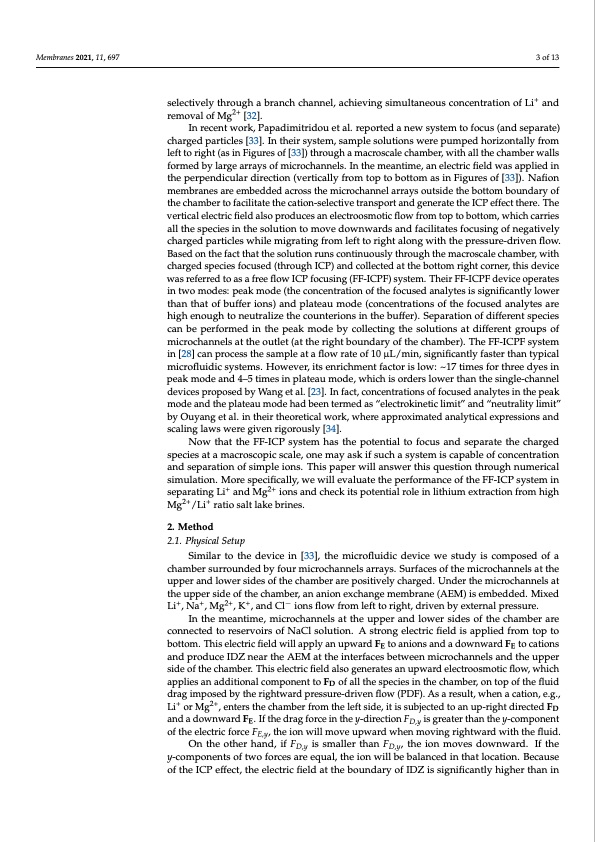
PDF Publication Title:
Text from PDF Page: 003
Membranes 2021, 11, 697 3 of 13 selectively through a branch channel, achieving simultaneous concentration of Li+ and removal of Mg2+ [32]. In recent work, Papadimitridou et al. reported a new system to focus (and separate) charged particles [33]. In their system, sample solutions were pumped horizontally from left to right (as in Figures of [33]) through a macroscale chamber, with all the chamber walls formed by large arrays of microchannels. In the meantime, an electric field was applied in the perpendicular direction (vertically from top to bottom as in Figures of [33]). Nafion membranes are embedded across the microchannel arrays outside the bottom boundary of the chamber to facilitate the cation-selective transport and generate the ICP effect there. The vertical electric field also produces an electroosmotic flow from top to bottom, which carries all the species in the solution to move downwards and facilitates focusing of negatively charged particles while migrating from left to right along with the pressure-driven flow. Based on the fact that the solution runs continuously through the macroscale chamber, with charged species focused (through ICP) and collected at the bottom right corner, this device was referred to as a free flow ICP focusing (FF-ICPF) system. Their FF-ICPF device operates in two modes: peak mode (the concentration of the focused analytes is significantly lower than that of buffer ions) and plateau mode (concentrations of the focused analytes are high enough to neutralize the counterions in the buffer). Separation of different species can be performed in the peak mode by collecting the solutions at different groups of microchannels at the outlet (at the right boundary of the chamber). The FF-ICPF system in [28] can process the sample at a flow rate of 10 μL/min, significantly faster than typical microfluidic systems. However, its enrichment factor is low: ~17 times for three dyes in peak mode and 4–5 times in plateau mode, which is orders lower than the single-channel devices proposed by Wang et al. [23]. In fact, concentrations of focused analytes in the peak mode and the plateau mode had been termed as “electrokinetic limit” and “neutrality limit” by Ouyang et al. in their theoretical work, where approximated analytical expressions and scaling laws were given rigorously [34]. Now that the FF-ICP system has the potential to focus and separate the charged species at a macroscopic scale, one may ask if such a system is capable of concentration and separation of simple ions. This paper will answer this question through numerical simulation. More specifically, we will evaluate the performance of the FF-ICP system in separating Li+ and Mg2+ ions and check its potential role in lithium extraction from high Mg2+/Li+ ratio salt lake brines. 2. Method 2.1. Physical Setup Similar to the device in [33], the microfluidic device we study is composed of a chamber surrounded by four microchannels arrays. Surfaces of the microchannels at the upper and lower sides of the chamber are positively charged. Under the microchannels at the upper side of the chamber, an anion exchange membrane (AEM) is embedded. Mixed Li+, Na+, Mg2+, K+, and Cl− ions flow from left to right, driven by external pressure. In the meantime, microchannels at the upper and lower sides of the chamber are connected to reservoirs of NaCl solution. A strong electric field is applied from top to bottom. This electric field will apply an upward FE to anions and a downward FE to cations and produce IDZ near the AEM at the interfaces between microchannels and the upper side of the chamber. This electric field also generates an upward electroosmotic flow, which applies an additional component to FD of all the species in the chamber, on top of the fluid drag imposed by the rightward pressure-driven flow (PDF). As a result, when a cation, e.g., Li+ or Mg2+, enters the chamber from the left side, it is subjected to an up-right directed FD and a downward FE. If the drag force in the y-direction FD,y is greater than the y-component of the electric force FE,y, the ion will move upward when moving rightward with the fluid. On the other hand, if FD,y is smaller than FD,y, the ion moves downward. If the y-components of two forces are equal, the ion will be balanced in that location. Because of the ICP effect, the electric field at the boundary of IDZ is significantly higher than inPDF Image | Brines Based on Free Flow Ion Concentration Polarization

PDF Search Title:
Brines Based on Free Flow Ion Concentration PolarizationOriginal File Name Searched:
membranes-11-00697-v2.pdfDIY PDF Search: Google It | Yahoo | Bing
Product and Development Focus for Infinity Turbine
ORC Waste Heat Turbine and ORC System Build Plans: All turbine plans are $10,000 each. This allows you to build a system and then consider licensing for production after you have completed and tested a unit.Redox Flow Battery Technology: With the advent of the new USA tax credits for producing and selling batteries ($35/kW) we are focussing on a simple flow battery using shipping containers as the modular electrolyte storage units with tax credits up to $140,000 per system. Our main focus is on the salt battery. This battery can be used for both thermal and electrical storage applications. We call it the Cogeneration Battery or Cogen Battery. One project is converting salt (brine) based water conditioners to simultaneously produce power. In addition, there are many opportunities to extract Lithium from brine (salt lakes, groundwater, and producer water).Salt water or brine are huge sources for lithium. Most of the worlds lithium is acquired from a brine source. It's even in seawater in a low concentration. Brine is also a byproduct of huge powerplants, which can now use that as an electrolyte and a huge flow battery (which allows storage at the source).We welcome any business and equipment inquiries, as well as licensing our turbines for manufacturing.| CONTACT TEL: 608-238-6001 Email: greg@infinityturbine.com | RSS | AMP |